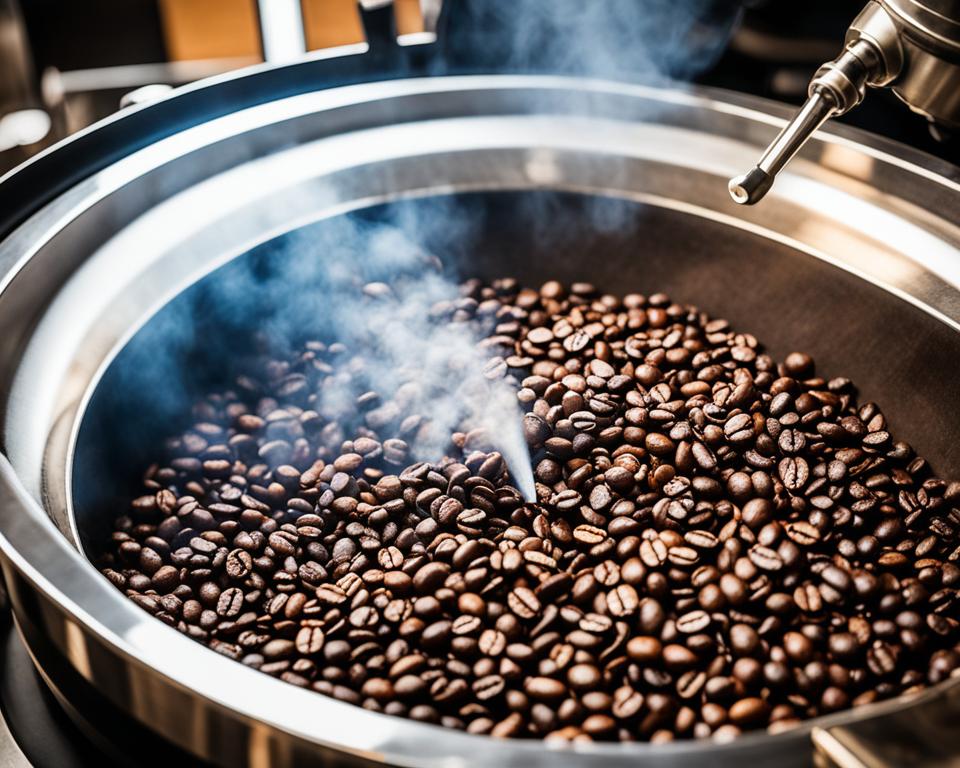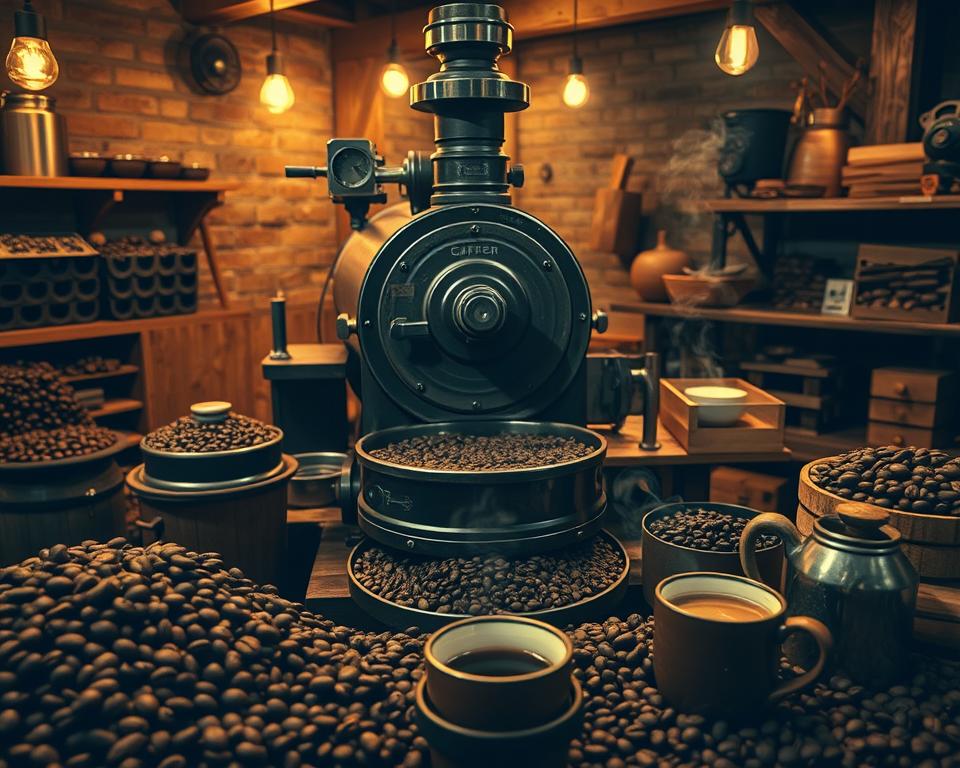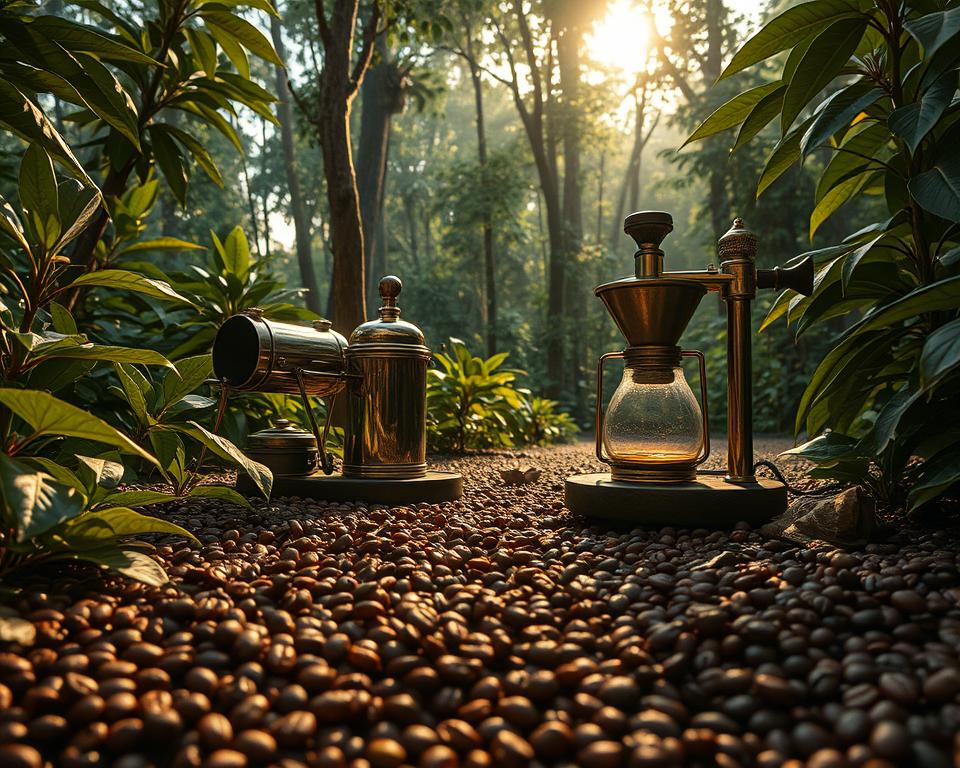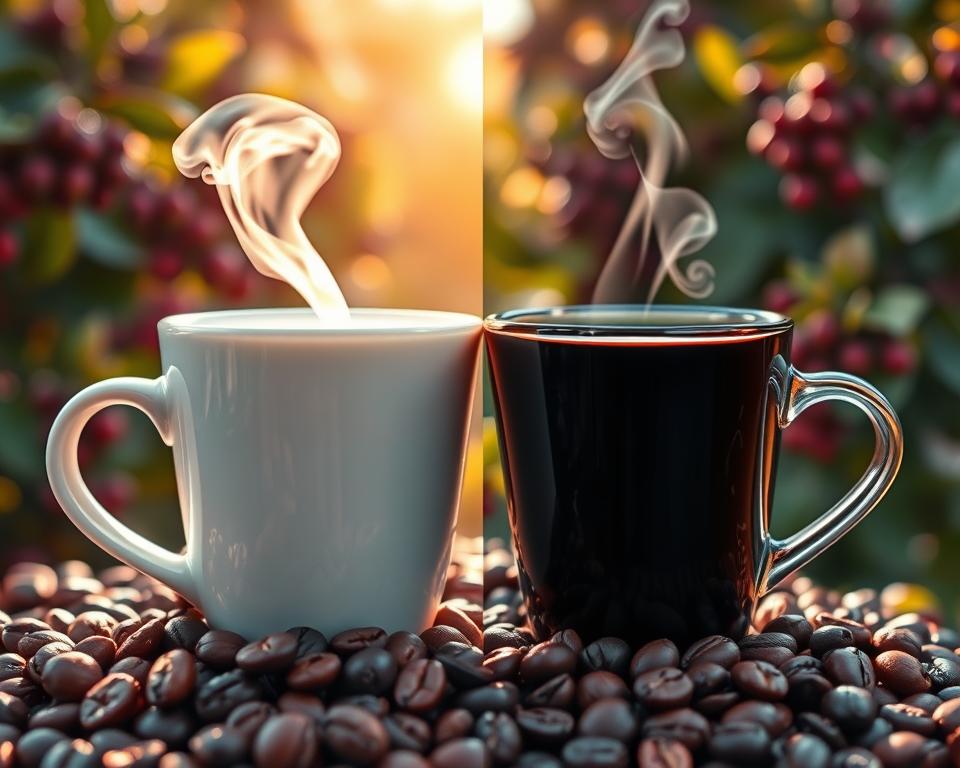Did you know that over 800 different aroma compounds can be generated during the coffee roasting process? It’s amazing how roasting does affect coffee, transforming a simple green coffee bean into a complex, flavorful delight.
This evolution in taste and aroma is what makes coffee roasting such a fascinating art.
Roasting coffee beans isn’t just about turning them brown. It’s a meticulous process that involves carefully timed and temperature-controlled stages.
At the heart of this transformation are the Maillard reaction and caramelization, which are key to coffee taste enhancement. These chemical reactions are essential to developing the unique flavours and aromatic potential of your favourite cup of Joe.
Have you ever wondered why your coffee smells so good? It’s all thanks to the skilled roast master, who knows just the right moment to unlock those captivating aromas.
Join me as we explore how different roast levels can create a symphony of flavours that makes every sip an experience to savour.
The Basics of Coffee Roasting
Roasting coffee beans is a crucial process that transforms green coffee beans into the aromatic, flavour-packed coffee we enjoy daily.
Understanding the stages of how roasting affects coffee? Its significance can enhance our appreciation of each cup.
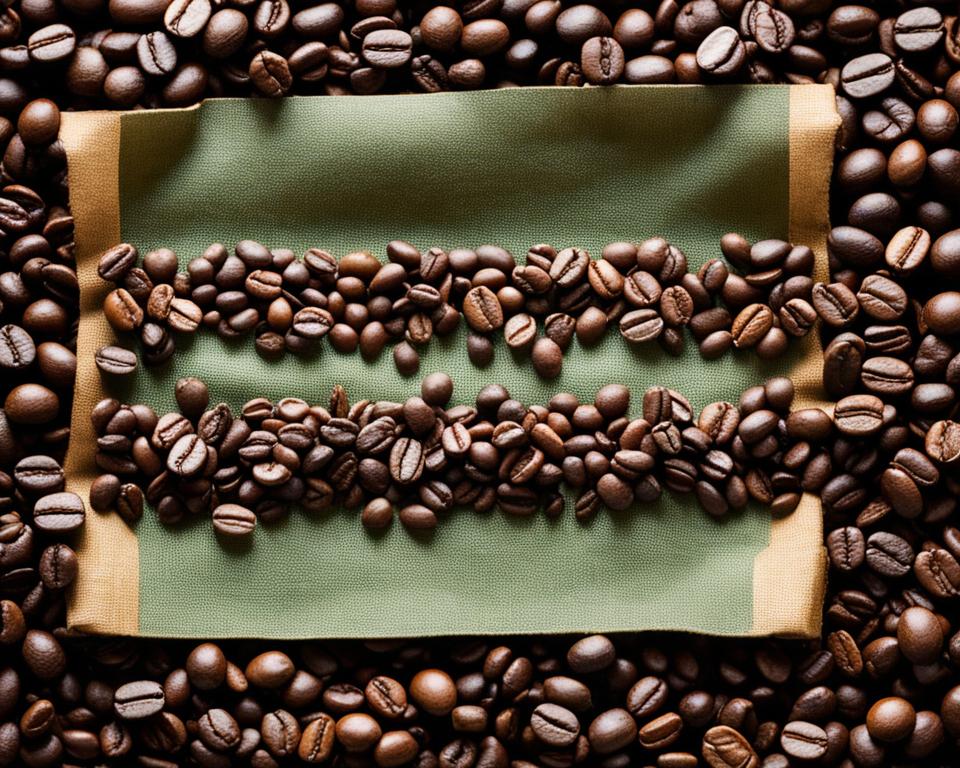
What is Coffee Roasting?
At its core, coffee roasting refers to the process in which green coffee beans are heated to develop their flavour. By carefully controlling the temperature and time, roast masters unlock complex flavor profiles in coffee beans.
Whether it’s a light, medium, or dark roast, each profile stems from a unique roasting process.
The Different Roasting Stages
The stages of coffee roasting include drying, the first crack, and development. Each plays a significant role in the final flavour profile. During the drying stage, beans lose moisture, paving the way for further roasting.
The first crack marks a pivotal moment where beans begin to release carbon dioxide and expand, highlighting the initial development of flavours.
Lastly, the development stage allows for the perfect balance between acidity, sweetness, and bitterness.
How does roasting affect coffee?
The significance of roasting in coffee making cannot be overstated. It’s the stage where coffee’s true character is formed. The roast master’s expertise ensures that each batch reaches its full potential, balancing the intricate flavours and aromas.
This careful process distinguishes a good cup of coffee from a great one, making roasting coffee beans an art and science in its own right.
Light Roast Coffee: How does roasting affect coffee?
Light-roasted coffee offers a unique experience, inviting coffee lovers to explore its delicate and complex profiles.
Light roasts bring out the inherent qualities of the coffee bean with their lighter body and higher acidity.
Characteristics of Light Roast
One of the key light roast coffee characteristics is the lighter colour and lack of oil on the surface. These beans are roasted until they just reach the first crack, preserving much of their original flavour.
This results in a cup that’s bright, tangy, and full of nuanced coffee flavours.
Flavor Notes in Light Roast
When sipping on a light roast, you’ll often notice a surprising array of flavors. These can range from fruity to floral, with common notes including citrus, berry, and jasmine.
Unlike darker roasts, which can overshadow these nuances, light-roasted coffee lets each flavour shine through.
The aroma of Light Roast
The light roast aroma profiles are equally appealing. These coffees typically exude a scent that’s fresh and fragrant, often described as floral or even like toasted grain.
The light roast aroma profiles can transport you to a field of blooming flowers or a cosy bakery.
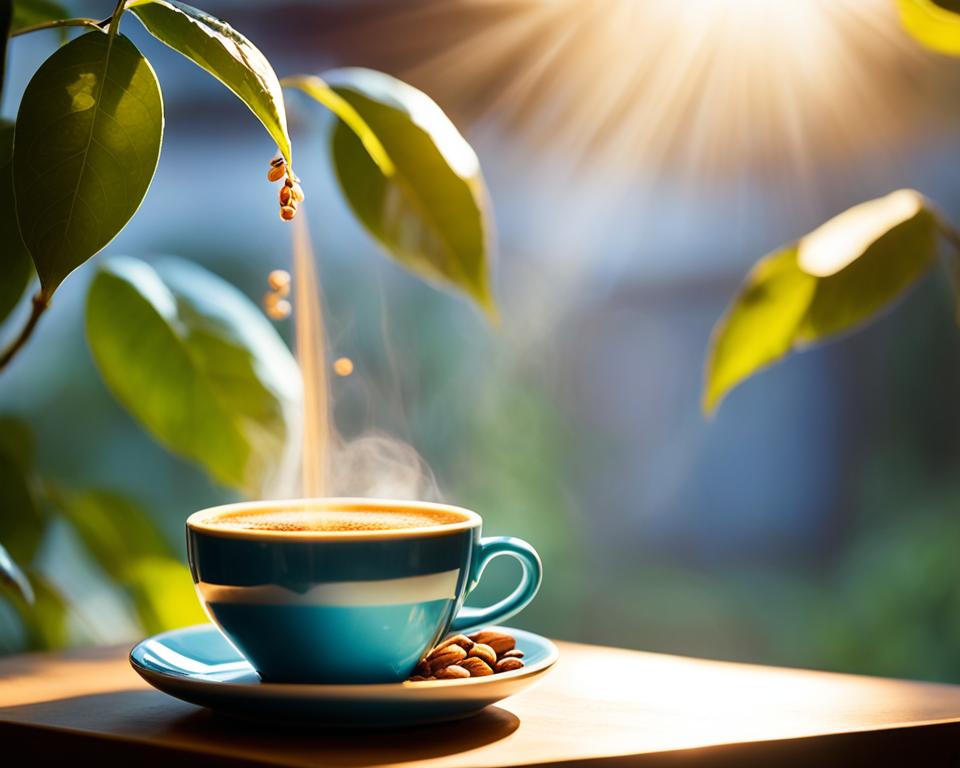
I still remember my first sip of light roast coffee—it was like discovering a whole new world within my cup. Have you tried light roast?
What flavours and aromas stood out to you? How does roasting affect coffee? The beauty of a light roast lies in its ability to highlight the true essence of the coffee bean.
Explore it, and you might find your new favourite brew.
Medium Roast Coffee: Balanced Flavors
Indulge in the delightful harmony of medium-roasted coffee, which delivers a luxurious and velvety flavour that captivates coffee lovers everywhere.
Unlike light or dark roasts, this level of roasting maintains the beans’ natural flavours while enhancing them with a bit of caramelised sweetness and a touch of nuttiness.
Characteristics of Medium Roast
Medium roasts showcase a brown color that’s not too light or dark, with little to no oil on the surface of the beans. They offer a balanced coffee flavor with mild acidity and a well-rounded body, making each sip smooth and fulfilling.
This roast level is often described as the sweet spot where the true essence of the coffee bean is neither underdeveloped nor overly robust.
Flavor Profile of Medium Roast
Fans of medium-roasted coffee will appreciate its harmonious blend of flavors. You can expect a delightful mix of fruity, nutty, and sometimes chocolatey notes.
This variety creates a versatile cup ideal for any time of the day. The moderate roasting process allows for the sugars in the beans to caramelize just enough, resulting in a complex and layered taste that’s hard to resist.
Aromatic Qualities
The medium-roasted aroma is indeed captivating. As you brew a cup, you’ll notice a delightful fragrance that’s both inviting and comforting.
The aroma can range from sweet and fruity to warm and nutty, making it accessible to a broad spectrum of coffee drinkers.
This pleasing scent is a direct result of the balanced roasting process that preserves and highlights the coffee’s intrinsic qualities.
Understandably, the benefits of medium-roasted coffee make it a favourite for many. It offers a satisfying compromise between the sharp brightness of light roasts and the intense boldness of dark roasts.
Whether you’re new to coffee drinking or a seasoned aficionado, medium roast offers a delightful middle ground that’s sure to please your palate.
Dark Roast Coffee: How does roasting affect coffee?
Taking a sip of dark-roasted coffee feels like a bold adventure. The robust, full-bodied roast is a staple for many coffee lovers.
Characteristics of Dark Roast
One thing you can’t miss with dark roast coffee is its intense coffee aroma. The beans, roasted longer and at higher temperatures, take on a deep, rich color.
This process brings the natural oils to the surface, giving the beans a shiny appearance. These oils contribute to the full-bodied roast that many find irresistible.
Flavor Profile of Dark Roast
The dark roast coffee flavor is known for its bold, rich taste, often accompanied by a slight bitterness. Yet, it’s this very boldness that appeals to many coffee aficionados.
This roast level brings out deep, smoky flavors that can make any coffee moment special. It’s less acidic than lighter roasts, making it a satisfying choice for those seeking a powerful coffee experience.
How Does Roasting Affect Coffee?
Ever wondered what really happens to your coffee beans during roasting? The transformation is quite fascinating.
Let’s break down the process and understand how roasting affects coffee, the flavor and aroma, and the chemistry of our beloved coffee.
Bean Structure Changes
Roasting coffee isn’t just about heating the beans. The roasting impact on coffee begins with changes in the bean’s structure.
As the beans are heated, they lose moisture and expand in size. This process cracks the beans, changing their density and making them more brittle.
Development of Flavors
The magic of flavor development happens through chemical reactions. A crucial one is the Maillard reaction, where sugars and amino acids interact, creating complex flavors.
Another key process is caramelization, where sugars break down into simpler compounds, adding sweetness. Coffee bean chemistry plays a vital role in developing these rich flavors.
Impact on Aroma
What about the aroma? It’s all about the oils and volatile compounds released during roasting. As beans crack and release oils, they emit a range of aromas, from fruity to nutty, depending on the roast level.
Whether you love a light roast with floral notes or a dark roast with smoky tones, the roasting impacts coffee aromas significantly.
The Science Behind Coffee Roasting
Have you ever wondered how coffee roasting transforms those green beans into the rich, aromatic coffee we love? It’s all thanks to a fascinating mix of coffee chemistry and advanced roasting technology.
First, let’s talk about heat transfer. Roasting relies on three primary mechanisms: thermal conduction, convection, and radiation.
These processes work together to achieve an even roast. Each method of heat transfer impacts the beans differently, influencing their flavour and texture.
Conduction occurs when the beans make direct contact with the hot surface of the roaster. This direct transfer of heat is essential for developing the initial roasted flavours.
Convection, on the other hand, involves the circulation of hot air around the beans, ensuring that heat penetrates evenly. And lastly, radiation contributes to the process by emitting infrared energy that gently cooks the beans from the outside in.
The magic happens when heat is applied, triggering a series of chemical reactions. One critical reaction is the Maillard reaction, where amino acids and sugars interact to create complex flavour compounds.
This reaction is responsible for the brown colour and the rich, nutty, and toasty flavours in roasted coffee.
Another process at play is caramelization. As the beans heat up, their natural sugars begin to break down and caramelise, adding sweetness and contributing to the overall flavour profile.
These reactions underline the importance of roasting technology and its precise control mechanisms that enable roasters to manipulate flavour development expertly.
Scientific principles guide every stage of the roasting process. From the initial drying phase, which preps the beans by evaporating moisture, to the critical first crack when beans expand and release carbon dioxide,.
These detailed steps form the foundation of our flavorful brew, showcasing the scientific approach to coffee.
Understanding the coffee chemistry behind roasting enriches your appreciation for every cup. Next time you sip your favourite blend, remember the meticulous science and roasting technology that crafted those delightful flavours.
Personal Tips for Enjoying Different Roasts
Enjoying coffee is such a personal journey. To find what suits your taste buds, exploring different roasts and brewing techniques is essential.
Here are some tips to make your coffee experience even better.
Finding Your Preferred Roast
Discovering coffee roasts starts with sampling various types. Light roasts bring out the bean’s natural flavors, while dark roasts offer a robust, smoky taste.
Try different roasts from brands like Stumptown or Intelligentsia to identify your favorite. Pay attention to flavor notes mentioned on the packaging; this helps in understanding your preferences.
Experimenting with Brewing Methods
The way you brew your coffee can significantly change its taste. Methods like pour-over, French press, or AeroPress each yield distinct flavors.
I love using a Chemex for my light roast to highlight its delicate notes. Try different brewing techniques to see which one enhances your chosen roast.
Pairing with Food
Coffee and food pairings can elevate your tasting experience. Enjoying a medium roast with a chocolate croissant is my go-to breakfast.
Light roasts pair excellently with citrus desserts, while dark roasts complement rich foods like dark chocolate or steak. Experiment with pairings to find combinations that delight your palate.
By discovering coffee roasts, trying various coffee brewing techniques, and exploring coffee and food pairings, you’re set to enjoy a richer coffee experience.
So, go ahead and make your coffee journey uniquely yours!
How Do Different Roasting Levels Impact the Flavor and Aroma of Coffee?
Coffee lovers often debate blonde versus medium roast flavors, as each brewing level unlocks unique taste profiles. Blonde roasts offer brighter, tangy notes, highlighting the coffee’s natural acidity and floral hints. In contrast, medium roasts balance sweetness and body, revealing richer caramel and chocolate undertones that appeal to many palates.
Conclusion:
Reflecting on our journey through the coffee roasting process, it’s clear that roasting is more than just a step—it’s an art that transforms humble green beans into flavorful, aromatic treasures.
Each roast level, from light to dark, brings unique characteristics to the table, offering a plethora of taste and aroma profiles that cater to diverse palates.
From understanding the essentials of the basics of coffee roasting to grasping the specifics of light, medium, and dark roasts, we’ve explored how crucial parameters such as time and temperature sculpt the final flavour.
The science behind roasting and the chemistry involved reveal just how intricate and fascinating the process can be.
My goal was to enrich your coffee experience, shedding light on how the roast level affects everything from bean structure to aroma. Whether you prefer the bright flavours of a light roast or the deep, intense notes of a dark roast, experimenting with different roasts and brewing methods will undoubtedly enhance your appreciation for this beloved beverage.
So, as you sip your next cup, take a moment to savour the nuanced world of flavours and aromas, knowing a bit more about the coffee roasting journey that makes it possible.
FAQ
What is coffee roasting?
Coffee roasting is the process of heating green coffee beans to transform them into the roasted coffee we enjoy drinking. The process involves exposing the beans to high temperatures, which causes them to undergo chemical and physical changes, unlocking the flavours and aromas that are characteristic of coffee.
What are the different stages of coffee roasting?
The stages of coffee roasting typically include drying, the first crack, and development. The drying stage removes the moisture from beans; the first crack is an audible cue indicating the beans’ structure is breaking down; and the development stage allows the desired flavours and aromas to develop fully.
How does roasting affect coffee?
Roasting is crucial because it defines the coffee’s flavour profile and aroma. It’s at this stage that the beans’ potential is realised, turning basic green beans into the complex and delightful coffee that we drink. The timing, temperature, and techniques used in roasting determine the final taste, from light and fruity to bold and intense.
What are the characteristics of light-roasted coffee?
Light roast coffee is known for its light body, high acidity, and bright flavours, often with fruity or floral notes. Because they are not roasted for long, the natural characteristics of the beans are more pronounced, delivering a nuanced and delicate cup of coffee.
What flavour notes can I expect in light-roasted coffee?
In light roast coffee, you might find a variety of flavour notes, such as citrus, berry, and floral undertones. The lighter roasting preserves the natural flavours of the coffee bean, which can vary widely depending on its origin.
What aroma is typical of light-roasted coffee?
Light roast coffees often have a subtle and delicate aroma, sometimes described as having hints of toasted grain or fresh fruit. The lighter roast profile tends to enhance the bean’s original aromatic qualities.
What are the characteristics of medium-roasted coffee?
Medium-roasted coffee features a balanced flavour profile, blending the acidity of a light roast with the fuller body of a dark roast. It usually boasts rich, smooth, and mellow flavours, making it a favourite for many coffee drinkers.
What is the flavour profile of medium-roasted coffee?
Medium-roasted coffee often has a well-rounded flavour with balanced acidity and body. You can expect a variety of taste notes, from fruity to nutty, and even a hint of chocolate, providing a complex yet harmonious cup.
What are the aromatic qualities of medium-roasted coffee?
The aroma of medium-roasted coffee is pleasing and diverse, often described as sweet and toasty, with nuances that can range from fruity to slightly spicy. This roast level brings out a balanced mix of the beans’ inherent aromas and those developed during roasting.
What are the characteristics of dark-roasted coffee?
Dark roast coffee is famed for its bold and robust flavour, with a full body and low acidity. The beans are roasted longer, resulting in a dark colour and a more intense, sometimes smoky, flavour profile.
What can I expect from the flavour profile of dark-roasted coffee?
Dark-roasted coffee typically has rich, deep flavours with a pronounced bitterness that is balanced by the intensity of the roast. You’ll often find notes of dark chocolate, caramel, or even a slightly charred taste.
How does roasting affect the structure of coffee beans?
Roasting causes coffee beans to expand and lose moisture, changing their internal structure. This transformation is essential for developing the flavours and aromas we enjoy. The beans go from dense and green to brown and porous, ready to be ground and brewed.
How does roasting develop coffee flavours?
Roasting triggers chemical reactions, such as the Maillard reaction and caramelization, that develop complex flavours from the basic compounds in the green beans. The careful control of heat and time during roasting allows for a range of flavours, from sweet and fruity to rich and smoky.
What impact does roasting have on coffee aroma?
Roasting significantly enhances coffee’s aroma, releasing a variety of volatile compounds that contribute to the olfactory experience. The depth and type of aroma achieved depend on the roast level, with lighter roasts being more delicate and darker roasts being more robust and intense.
How can I find my preferred roast?
To find your preferred roast, try sampling different roast levels and noting your taste and aroma preferences. Light roasts are typically more acidic and fruity, while dark roasts are bold and bitter. Medium roasts offer a balanced profile. Experimenting will help you discover what you enjoy most.
How can I experiment with brewing methods?
Experimenting with different brewing methods can highlight various aspects of your coffee roast. For example, a French press will bring out the rich body of a medium or dark roast, while a pour-over method can accentuate the bright notes of a light roast. Each brewing method extracts flavours differently, offering unique perspectives on the same coffee.
What foods pair well with different coffee roasts?
Pairing coffee with food can enhance your tasting experience. Light roasts pair well with lighter foods like fruit and pastries. Medium roasts complement a variety of foods, from breakfast items to desserts. Dark roasts can stand up to richer, bolder flavours, such as chocolate or barbecue.

